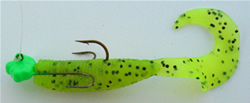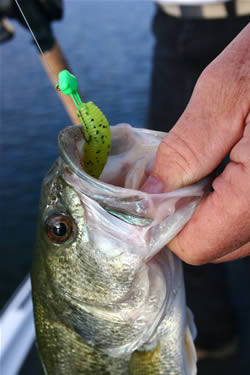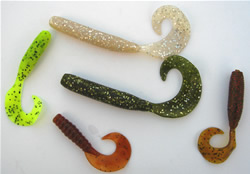|
||
|
|
Ten Ways To Fish A GrubBy Margie Anderson To a bass fisherman, the word grub means fish – big fish – and plenty of them! The humble little grub is one of the most versatile and effective lures you can have in your tackle box, and to prove it, we’ll start you out with 10 ways to catch fish on a grub. Topwater Grubbing Catching bass on a topwater grub rates extremely high on the fun-o-meter. Rig a 5- or a 7-inch grub on a big wide-gap hook (about a 4/0 or 5/0) and rig it so the curve of the hook and the curve of the tail are pointing the same way. You can leave the hook exposed if there isn’t much cover sticking out of the water, or keep it skin-hooked if you need to fish the grub through weeds or brush. Cast the grub right to shore then just crank it back, swimming it across the top of the water. Phoenix angler John Anderson just loves this technique. “I like to use pretty heavy line so it keeps the grub from sinking,” Anderson says, “and I throw it on baitcasting tackle.” The big grub is easy to cast even on heavy line, and you’ll need that stoutness to set the hook. But, keep the nitroglycerin handy – when the fish start slamming this little flapper on top, it’s almost more than a person can stand! Drop-Shot A Grub
A grub suspended off a drop-shot rig looks too much like a particularly stupid and tasty minnow for most bass to resist. Tie a straight-shank hook onto your line a few feet up from the end, then attach a weight to the end. The length in between can be any length, says Mark Townsend of Tempe, who taught me to drop-shot. Use the lightest one that will let you feel the bottom. Then just drop it down under the boat into the fish and hold on. This is not usually a subtle bite – the fish grab it and run. Pea Heads And Cliffs Mike Baldwin has a lot of experience catching fish that really don’t want to cooperate. After all, his home lake is Havasu! In winter, Baldwin likes to put a grub on a little pea head jig and bounce it down the cliffs. He rigs the grub with the hook exposed and uses the lightest head he can get away with. The slower the fall, the better, he says, especially in really cold water. Baldwin uses spinning gear and Sugoi line so he can feel the tiniest pecks. “Cast right to shore and watch the line,” he says. “Let the lure fall until the line goes slack, then lift it up and let it fall to the next level.” If the line bounces, twitches, or moves sideways, haul off and reel in your bass, he advises. Also, if it feels mushy or heavy when you start to move the grub, set the hook! Trailing A Grub Grubs are not only fantastic lures to fish alone, but also they make one of the best trailers around. The fat little body of a grub adds bulk and color to a spinnerbait or buzzbait, and the long, sinuous tail adds action that no other plastic can match. Jim Furr likes to use a big grub so he gets the longest tail possible, but he pinches off a bit of the body so that it just fills up the hook shank and lets the tail undulate off the back of the lure. The attraction of the grub seems to help get solid bites, Furr says, especially if the short strikes are being caused by bass hitting the blades instead of the hook. You can match the grub to the lure or use a contrasting color to add a different dimension to the presentation. With a grub on the hook, you don’t even necessarily need the skirt, and I’ve caught many a nice bass on a spinnerbait with nothing on it but a grub. Swimming A Grub
Bertolero flattens the jigheads with a hammer then uses Super Glue to attach little eyes to the lead. These little eyes can be purchased at any craft or fabric store, and they’re cheap. Sometimes Bertolero paints the darter heads first. A grub rigged on one of these looks for all the world like a baitfish swimming by, and you can fish it as fast or as slowly as you need to. Bertolero finds them particularly effective in current, where he lets the water take them right to the fish. Smallmouth are really suckers for this presentation. On-A-Hair Jig Pitching a hair jig to tules and grass is a time-honored big-bass technique. Mike Baldwin does a lot of this kind of fishing, and instead of the traditional jig and pig, he prefers a jig and a grub. Pork has a tendency to flop around and get stuck on the hook, preventing you from getting it into the fish. It also dries out quickly and is a bit messy to use and keep. Grubs, either single or double-tail, make much better jig trailers, Baldwin says. He can pick just the perfect color for what he is doing, and he likes the action that the legs or tail gives to the jig. A single tail grub has less of a tendency to wrap around tules than a twin-tail does, but a twin-tail can give the impression of a crawdad. Baldwin says the key to this pitching is to look for the tules with the darkest water in front of them. This dark water is deeper, and those reeds usually hold the best and the most fish. Jerking A Grub A big grub makes a fantastic twitch bait, says Gary Dobyns. He likes to rig a grub weightless, on an open hook or Texposed, and twitch it over cover or structure. You fish this weightless grub like a Senko, but it has a little more action because of the tail. The twitching grub with its waving tail moves a lot of water, which can attract bass from greater distances, especially in dirty water or heavy cover. Throw the grub right to shore then work it back with erratic twitches of your rod. When you get it over a good-looking tree or some brush, or a hole in the weeds, stop and let it sink for a few seconds before giving it a couple of tiny little tics. This can draw savage strikes, so be ready to set the hook. Another advantage of this jerkbait grub is that it can be worked through even the thickest weeds without getting snagged like a regular hard jerkbait would. Flipping A Grub Jerry Suk taught me to flip many years ago. Since then I’ve been on a flipping bite many times with many different anglers, but I’ve never found a bait I like better than a big Yamamoto grub. Suk keeps about a million 5- and 7-inch smoke/sparkle Yamamoto grubs in his boat, and he uses them to coax huge bass out of the heaviest cover you can imagine. Suk never pegs his sinkers because he says the line twitches a little more if the sinker is loose. He uses a flipping stick that resembles a broomstick, and very heavy line. The grub, he says, slips through cover easily, especially with the addition of a little scent to “grease it up”. If you ever fished with Suk, you’d swear he was psychic, knowing that a fish was biting through some paranormal means. But, Suk is a line-watcher. He drops the grub into trees or brush and the least little disturbance of the line will trigger a swing from him that sounds like a high-voltage power line. He’s probably caught more fish on grubs than anyone else I know. When Fishing Gets Tough, Go Split-Shotting When fish just do not want to chase down anything fast or gaudy, a split-shot rig may be the only way to get bit. Gregg Warne knows this better than most, and he has been known to move along right behind other anglers and pull big fish off banks that have just been worked over. The key to his success is patience and the right equipment. Warne uses a rather stiff spinning rod, a reel that takes up plenty of line fast, and good sharp Gamakatsu hooks. He also uses a lot of grubs. He’ll use the lightest weight that he can feel on the bottom, even if it means “having a Pepsi while you wait for your bait to hit bottom.” Warne drops his rig, lets it hit bottom, then moves it ever so slowly along at the depth the fish are using. For really deep fish, his leader may be 3 or 4 feet long. He holds his rod loosely and lets it point back toward the lure. When a fish picks up his grub, he swings the rod up and around, reeling at the same time. The fine-wire hooks slip in easily, but you can lose a good fish if you horse it too hard. Take your time. Split-shotting is not for the hyperactive, but it sure is a good grubbing technique when the fish have lockjaw. Football Grubs Possibly the most popular way to fish a twin-tail grub is on a football head jig. Since these jigs come in a raft of sizes, you can fish them at just about any depth and with a huge variety of presentations. You can drag them on deep-water structure, bounce them down steep stuff, crash them on rocks, or swim them down the center of a channel. The possible combinations of skirts and twin-tails is almost infinite, so you can match just about any baitfish or crawly thing in any lake. Hula grubs in single or double-tail are also favorites on football heads, but separate skirts and grubs give you a whole lot of color choices. This is a jig and grub combo with a reputation for catching big bass, and no serious angler should venture out without a good selection of these lures stashed in his box. A grub can look like almost anything you want it to if you know how to work it right. Twitched, swum, dragged, or just hanging there, a grub is something that a bass just can’t resist. With the enormous variety of colors and sizes available, you can find a grub to suit any condition. Try a grub on your favorite rig next time you go out – they are versatile enough for just about anything, and they really catch fish. |
|
 April
2007
April
2007 Grub — what a horrible little name for such excellent bait! The word “grub” conjures up some pretty nasty images unless you are a bass fisherman.
Grub — what a horrible little name for such excellent bait! The word “grub” conjures up some pretty nasty images unless you are a bass fisherman.  What do you do if every fish you see on your graph is suspended? Those horrible hanging bass will often take a little (try the 3-inch model) grub if you fish it on a drop-shot rig right where they’re hanging.
What do you do if every fish you see on your graph is suspended? Those horrible hanging bass will often take a little (try the 3-inch model) grub if you fish it on a drop-shot rig right where they’re hanging.  A darter head jig is flat instead of round, so it cuts through the water cleanly and can maneuver through grass, tules, and brush with ease. A California angler named Leroy Bertolero showed me some customized darter heads that he makes for fishing grubs through cover.
A darter head jig is flat instead of round, so it cuts through the water cleanly and can maneuver through grass, tules, and brush with ease. A California angler named Leroy Bertolero showed me some customized darter heads that he makes for fishing grubs through cover.